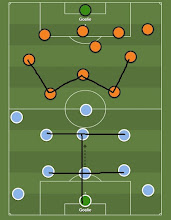The 2003 U20 World Cup marked the continuation of Brazil’s footballing dominance, following the senior team’s World Cup triumph just a year earlier.
Inspired by the brilliance of Ronaldo, Ronaldinho, and Rivaldo in Japan and South Korea, the young Seleção arrived at the tournament without much fanfare but grew stronger as the competition went on. Led by Dani Alves, Marcos Paquetá’s side didn’t dazzle with the trademark samba flair of their seniors under Luiz Felipe Scolari. Instead, they relied on a more physical, disciplined style — built on a solid defence and deadly set pieces.
Facts and Figures
The tournament
was originally scheduled for March 25 to April 16 but was postponed to November
27–December 19 due to the U.S. invasion of Iraq earlier that year.
* Four cities
hosted the matches: Abu Dhabi, Dubai, Sharjah, and Al Ain.
* Uzbekistan,
Slovakia, Burkina Faso, and Panama made their debuts.
* For the first time, the tournament’s best player award went to an Asian footballer — the hosts’ own Ismail Matar.
Latin Flair Dominates the Final Four
Latin football ruled the desert in 2003. Three South American teams — Brazil, Argentina, and Colombia — reached the semifinals, joined by Spain, representing Europe’s Latin heritage. Both Brazil and Spain had to grind their way through the knockout rounds after finishing as runners-up in their groups.
The Seleção edged past Slovakia and arch-rivals Argentina, hammering Japan along the way, while Spain overcame Paraguay, Canada, and Colombia to reach the final.
The title decider was tense and cagey, with both sides creating chances but finding no breakthrough until the very end. With just three minutes left on the clock, Fernandinho rose highest to head home the only goal of the match — sealing Brazil’s triumph and cementing the new generation’s place in the nation’s footballing legacy.
Tournament Highlights
Group Stage final standings (The one in bold advanced to the knockout stage, the top two from each group, plus best third place)
|
Grup A |
Grup B |
Grup C |
|
Burkina Faso |
Argentina |
Australia |
|
Slovakia |
Spain |
Brasil |
|
UEA |
Mali |
Canada |
|
Panama |
Uzbekistan |
Czech Rep |
|
Grup D |
Grup E |
Grup F |
|
Japan |
Ireland |
USA |
|
Colombia |
Ivory Coast |
Paraguay |
|
Egypt |
Saudi Arabia |
South Korea |
|
England |
Mexico |
Germany |
** = penalties
* = extra time
Round of 16:
-
Burkina
Faso vs Canada 0-1
-
Paraguay
vs Spain 0-1
-
Ireland
vs Colombia 2-3*
-
Australia
vs UEA 0-1
-
Japan
vs South Korea 2-1*
-
Brasil
vs Slovakia 2-1*
-
USA
vs Ivory Coast 2-0
-
Argentina
vs Egypt 2-1
Quarterfinals:
-
Canada
vs Spain 1-2*
-
Colombia
vs UEA 1-0
-
Japan
vs Brasil 1-5
-
USA
vs Argentina 1-2*
Semifinals:
-
Spain
vs Colombia 1-0
-
Brasil
vs Argentina 1-0
3rd place playoff: Colombia vs Argentina 2-1
Final: Brasil vs Spain 1-0
Top scorer: Eddie Johnson
(USA) – 4 gol
MVP: Ismael Matar (UEA)
From Youth to Stardom
Compared to previous editions under the 24-team format, the 2003 U20 World Cup produced fewer players who went on to shine at senior level. Yet several names from the tournament went on to become key figures for both club and country over the years.
Among them are James Milner, former Aston Villa, Manchester City and Liverpool man, and Japanese goalkeeper Eiji Kawashima, now with Strasbourg. There’s also Fernandinho, who enjoyed a long spell at Manchester City, Australia’s Mile Jedinak, Argentina’s Carlos Tevez, and the celebrated Barcelona trio of Andrés Iniesta, Dani Alves, and Javier Mascherano.
Here are some of
the standout players from the 2003 U20 World Cup who later became stars at
senior level:
|
Players |
World Cup
Edition (senior) |
|
Daniel Yeboah
(Ivory Coast) |
2010 |
|
Arouna Kone
(Ivory Coast) |
2006 |
|
Sol Bamba
(Pantai Gading) |
2010 |
|
Alex Wilkinson
( |
2014 |
|
Mile Jedinak ( |
2010, 2014,
2018 |
|
Carl Valeri ( |
2010 |
|
Matt McKay ( |
2014 |
|
Michael
Thwaite ( |
2014 |
|
Dani Alves
(Brasil) |
2010, 2014,
2022 |
|
Nilmar
(Brasil) |
2010 |
|
Jefferson
(Brasil) |
2014 |
|
Fernandinho
(Brasil) |
2014, 2018 |
|
Atiba
Hutchison (Canada) |
2022 |
|
Gabriel Gomez
( |
2018 |
|
Marek Cech ( |
2010 |
|
Kamil Kopunek
( |
2010 |
|
Javier
Mascherano ( |
2006, 2010,
2014, 2018 |
|
Pablo Zabaleta
( |
2014 |
|
Carlos Tevez (Argentina) |
2006, 2010 |
|
Andreas
Iniesta (Spain) |
2006, 2010,
2014, 2018 |
|
Juanfran
(Spain) |
2014 |
|
Robert Huth
(Germany) |
2006 |
|
Piotr
Trochowski (Germany) |
2010 |
|
Kim Young
Kwang (South Korea) |
2006 |
|
Oh Beom Seok
(South Korea) |
2010 |
|
Kim Jin Kyu
(South Korea) |
2006 |
|
Lee Ho (South
Korea) |
2006 |
|
Park Chu Young
(South Korea) |
2010, 2014 |
|
Edgar Barreto
( |
2006, 2010 |
|
Julio Dos |
2006 |
|
Nelson Valdez
( |
2006, 2010 |
|
Eddie Johnson
(USA) |
2006 |
|
Bobby Convey
(USA) |
2006 |
|
Clint Dempsey
(USA) |
2006, 2010,
2014 |
|
Ricardo Clark
(USA) |
2006 |
|
Fredy Guarin
(Colombia) |
2014 |
|
Abel Aguilar
(Colombia) |
2014, 2018 |
|
Ahmed Fathy (Egypt) |
2018 |
|
James Milner
(England) |
2010, 2014 |
|
Eiji Kawashima
(Japan) |
2010, 2014,
2018, 2022 |
|
Yasuyuki Konno
(Japan) |
2010, 2014 |


Comments
Post a Comment